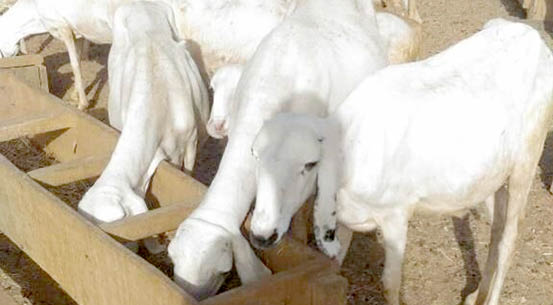External parasites can greatly impact wool quality in sheep, milk production in sheep and goats, and overall animal health. Therefore, it is very important to include a parasite control program in a herd health management plan. Increased regulations have removed many traditional pest control products from the market. With technological advancements, however, effective systemic parasite control is still possible.
With the use of any drug or chemical, following label instructions is imperative for getting the proper results while reducing the risk of product resistance.
Fleece worms (Wool maggots)
Even in well-managed flocks, fleece worms sometimes become a problem during a long stretch of cool, damp weather. Spraying the rear ends of the sheep is a good control and preventive measure under such conditions. High-pressure sprays (150–250 lb pressure) are best; however, if a low-pressure sprayer (50–150 lb pressure) is used, be sure to add 1–2 lb of household detergent per 100 gallons of water.
Secondary screwworms
Use 5% coumaphos (Co-Ral) dust or 2.5% ronnel (Korlan) livestock bomb as described earlier for fleece worms. No pre-slaughter interval is required with 5% coumaphos dust or 2.5% ronnel livestock bomb when used as a spot treatment.
- Despite drop in tomato, pepper prices, pests still lurk around
- Taraba goes into turmeric, ginger production
Sheep scab or scabies
Psoroptic scabies is thought to be eradicated in domestic sheep in the United States. Any sheep or goat suspected of being infected with scabies should be quarantined. Consult with your county Extension agent (https://aces.nmsu.edu/county/) or local veterinarian concerning regulations for treatment.
Sheep Lice
Lice will not be a problem in flocks sprayed or dipped regularly to control sheep ticks. Be sure all replacement ewes and rams are treated before they are added to the flock.
Ticks and Keds (Sheep Ticks)
Ticks are present in most rangelands. These insects not only spread disease but can also create ear infections if not controlled. Keds are wingless flies. Keds can be present year-round. Both insects can cause skin irritation, wool destruction, and even anemia if not controlled.
Treatment for sheep keds is easily applied and is often the most effective following spring shearing. Sheep keds should, however, be controlled any time significant numbers are found.
When heavily infested ewes are shorn, ticks will move to lambs that are still nursing. Consequently, treat lambs when the ewes are treated, but spray lightly and use EXTREME CAUTION when treating lambs under 3 months of age. DO NOT treat animals under 3 months of age with coumaphos under any circumstances.
Spraying or dipping once a year will usually keep sheep ticks under control. Be sure to treat all bucks and replacement ewes before adding them to the flock. Dipping does a more thorough job than spraying, but spraying can provide good control. High-pressure sprayers are more convenient and usually more effective for treating large flocks. An adequate job can be done with low-pressure sprayers (40–100 lb) if 1 to 2 pounds of household detergent are added to every 100 gallons of water.
General precautions
DO NOT spray animals in a confined, non-ventilated area.
DO NOT dip animals when they are thirsty or overheated. Water animals well before treatment so they will not drink the vat fluid.
DO NOT contaminate feed or drinking water.
DO NOT apply insecticides to sick animals or animals under stress.
DO NOT apply insecticides to lambs less than 3 months old, and use light applications on lambs 3 to 6 months old.
DO NOT treat animals with coumaphos 10 days before or after shipping or weaning or after exposure to contagious or infectious diseases.
DO NOT apply coumaphos, dioxathion, or ronnel to animals in conjunction with oral drenches or with internal medications such as phenothiazine, or natural or synthetic pyrethroids or their synergists, or with other organophosphates.
DO NOT use coumaphos, dioxathion, or ronnel on lactating milk goats.
Systemic options
There are many oral drench and injectable products on the market today that are effective in controlling both external and internal parasites (anthelmintics). These products tend to be more accepted across the industry, due to their efficacy, safety, and convenience. Table 2 provides product names, mode of administration, and parasites controlled.
Source: New Mexico State University

 Join Daily Trust WhatsApp Community For Quick Access To News and Happenings Around You.
Join Daily Trust WhatsApp Community For Quick Access To News and Happenings Around You.


